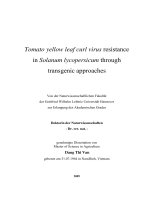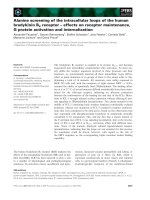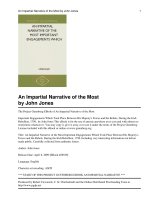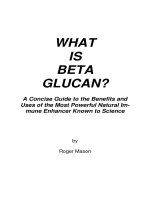Screening of mutant population (M2) for mungbean yellow mosaic virus resistance in french bean
Bạn đang xem bản rút gọn của tài liệu. Xem và tải ngay bản đầy đủ của tài liệu tại đây (527.47 KB, 6 trang )
Int.J.Curr.Microbiol.App.Sci (2019) 8(9): 1421-1426
International Journal of Current Microbiology and Applied Sciences
ISSN: 2319-7706 Volume 8 Number 09 (2019)
Journal homepage:
Original Research Article
/>
Screening of Mutant Population (M2) for Mungbean Yellow Mosaic Virus
Resistance in French Bean
T. C. Archith1*, V. Devappa1 and M. Chirag Reddy2
1
Department of Plant Pathology, of Horticulture, UHS campus, GKVK,
Bengaluru - 560 065, India
2
Department of Post harvest Technology, of Horticulture, UHS campus,
GKVK, Bengaluru - 560 065, India
*Corresponding author
ABSTRACT
Keywords
Mung bean,
Induced mutation,
Mungbean yellow
mosaic virus,
Scoring, Mutants.
Article Info
Accepted:
15 August 2019
Available Online:
10 September 2019
French bean is one of the most important legume vegetables with highly antidiabetic property and used for cardiac problems. Mungbean yellow mosaic
virus (MYMV) is one of the destructive viral diseases affecting yield potential
of french bean both quantitatively and qualitatively. Induced mutations have
offered a single and short alternative to conventional breeding including
isolation, screening, selection and testing generation after generation. An
investigation was carried out with Arka Anoop (French bean cultivar), treated
with mutagen Ethyl Methane Sulphonate (EMS) at the dose of 0.25 per cent.
The M2 generation were raised as an individual M1 plant basis. The control and
treated populations of M2 generation was carefully screened for pod shattering
resistance. The mungbean yellow mosaic virus disease incidence was recorded
for all the plants in M2 generation of the selected 250 mutants. Based on field
scoring, the mutants viz., M2 F28, and M2 F115, M2 F146, M2 F156, M2 F164,
M2 F165, M2 F217 were identified as mung bean yellow mosaic virus resistant
and moderately resistant mutants. These resistant mutants have been subjected
to next generation screening.
Introduction
French bean, (Phaseolus vulgaris L.) is a
diploid (2n = 22), with a relatively small
genome of 633 Mbp (Arumuganatham and
Earle, 1991). In India, it is extensively grown
in Himachal Pradesh, Punjab, Haryana,
Karnataka, Andhra Pradesh and Tamil Nadu.
Among the diseases, mung bean yellow
mosaic virus disease is a major one attacking
the crop, which is readily transmitted by
whiteflies. Disease symptoms vary from
irregular yellow patches of various sizes,
which coalesce to form larger patches of
1421
Int.J.Curr.Microbiol.App.Sci (2019) 8(9): 1421-1426
bright yellow colour and this is accompanied
with general stunting of plants. In severe
cases, entire leaves may turn yellow, plant
bears few flowers and small curved pods
(Chenulu et al., 1979).The yield loss due to
MYMV in french bean has not been
systematically studied. However, the yield
loss due to the MYMV in french bean is upto
100 per cent (Marimuthu et al., 1981). The
MYMV disease incidence varies from 10 to
100 per cent depending upon the susceptibility
of cultivars, crop season and population of
whitefly.
Mutation breeding provides the channel for
enhancing the genetic variation. Genetic
variability may also be created by modulating
the effects of mutagens. Adaptation of
mutation breeding is promising not only for
creating and utilizing the new variability but
also as an indispensable approach through
which disease resistance might be improved
without altering the existing desirable
characters. The use of resistant varieties is the
most desirable strategy to manage the disease
in an economical and environmentallyfriendly way (Sandhu and Singh, 1985).
Development of resistance varieties through
mutation against the viral diseases continues
to be a breeding priority. Hence, screening of
elite mutants for identifying resistance to
Mung bean yellow mosaic virus with high
yielding potential will help to increase the
production to a greater extent.
Materials and Methods
buffer at pH 8.5 for 4 hours. After 4 hours,
treated EMS seeds were washed under running
water for an hour to remove the traces of EMS
from the seed surface. Treated seeds along
with the parent were sown at a spacing of 30
X 15 cm to raise the M1 generation plants
during kharif season.
All M1 plants were harvested individually and
planted as plant progeny rows in M2
population along with parent and check
variety (Arka Komal) by following the
augmented block design during Summer at
Department of Plant Pathology block, College
of Horticulture, UHS Campus, GKVK,
Bengaluru. All the recommended agronomic
practices were adopted to raise the crop plants
except virus management.
Sowing of M2 population seeds in field
Sowing of M2 seeds which were collected
from the harvested M1 population was raised
along with parents and standard check
varieties in augmented block design at 30 x 15
cm spacing. Sowing was done during summer
season 2015. All the recommended agronomic
practices were adopted to raise the crop plant
as per the package of practices of UHS
Bagalkot except virus management. For M2
generation, the 20 seeds from each M1 plant
were sown in plant to row method with total
number of lines up to 250 and quantitative
observations were recorded.
Recording the
population plants
French bean seeds cv. Arka Anoop and Arka
Komal was collected from seeds Division,
India Institute of Horticulture Research
(IIHR), Bengaluru. One thousand seeds of
Arka Anoop, were treated with Ethyl Methane
Sulphonate (EMS) at the dose of 0.25 per cent.
Initially, seeds were soaked in distilled water
for 2 h and then treated with freshly prepared
0.25 per cent EMS solutions in phosphate
observation
on
M2
Out of 250 lines sowed, germination was
observed only in 214 lines hence data was
recorded on germinated lines only. Data was
recorded on various quantitative characters of
french bean listed in the NBPGR minimal
descriptors on five randomly selected
competitive plants in each of the families at
various phenophases of the crop.
1422
Int.J.Curr.Microbiol.App.Sci (2019) 8(9): 1421-1426
Scoring for disease incidence
For assessing the mungbean yellow mosaic
virus in french bean genotype, the intensity of
the MYMV was calculated according to
Banerjee and Kalloo (1987). Observations on
disease incidence were recorded in M2
generations at 30, 45 and 60 days after sowing
and the cumulative data were obtained to
assess the resistance of a given strain. In M2
generation individual plants were observed to
assess the disease incidence. Symptom
severity grades designated with numerical
values of 0 - 4 were given on the basis of
visual observation to quantify the disease
severity. The per cent disease incidence (PDI)
was calculated using the formula.
At the time of harvest only 300 plants were
harvested individually, out of which 250
plants were selected based on disease
resistance and visual observation of elite plant
characters like plant height, number of pods
and good plant type. No significant difference
was observed in plants of the M1 population as
compared to the parent population.
In M1 population, among 778 plants, 98 plants
were showing the symptoms of MYMV and
overall disease incidence of the plot was 12.5
per cent (Fig 1). In M2 generation, segregating
population was raised by growing 250 plant
progenies from M1 generation along with the
parent and check varieties. All the viable
morphological
mutants
were
scored
throughout the growth period. Results of M2
generation showed that line 207 exhibited
resistances, while few lines had moderate
resistance and rest lines were susceptibility
(Fig 2a).
Results and Discussion
Mungbean yellow mosaic virus is one of the
destructive viral disease affecting the yield
potential of french bean both quantitatively
and qualitatively. MYMV incidence was first
reported in India from the fields of IARI, New
Delhi by Nariani (1960). Over-reliance on the
usage of chemicals for the control is
associated with contamination of ecosystems
and also concerned on pathogen resistance
build up. Yet managing the disease by means
of resistant genotype is an effective, cheapest
and safest approach of disease control.
Improved resistance to MYMV disease is now
the major goal in french bean breeding
programs in several bean production countries.
In this study, the field screening for MYMV
resistance in M2 generation was carried out. In
M1 generation, 778 plants had survived out of
1000 seeds of Arka Anoop variety which was
treated with 0.25% EMS and subsequently the
seeds from M1 generation plants were
harvested individually after attaining full
maturity.
In 250 M2 populations, 214 lines had
germinated and screened for MYMV
incidence; there is no resistant mutant lines
evolved against MYMV except one lines
(Fig2b).
According to the scoring scale developed by
Banerjee and Kalloo (1987) for MYMV the
M2 population was categorized into different
groups. Out of 214 M2 populations screened, a
progeny line M2 F28 was observed as
resistant, with significant difference as
compared to checks (parent and Arka Komal)
in growth parameters. Other six progenies
(M2F115, M2F146, M2F156, M2F164, M2F
165 and M2F217) come under moderate
resistance and rest of all are highly susceptible
to MYMV (Table 1). At the initial stages of
growth some mutant population showed
resistant against MYMV but resistance was
broken down at final stage. The results are in
agreement with the findings of Karthikeyan et
al., (2012) and Chandra Paul et al., (2013).
1423
Int.J.Curr.Microbiol.App.Sci (2019) 8(9): 1421-1426
Table.1 Grouping of M2 population of french bean screened against MYMV during 2014-15
under irrigated conditions
Scale
0
1
3
5
7
9
Description
No plants showing any
symptoms
1% or less plants exhibiting
symptoms
1-10% plants exhibiting
symptoms
11-20% plants exhibiting
symptoms
21-50% plants exhibiting
symptoms
51% plants exhibiting
symptoms
Category/
Reaction
Immune
M2 population
Resistant
- M2 F 28-
Moderately
resistant
Moderately
susceptible
Susceptible
M2 F115, M2 F146, M2 F156, M2 F164, M2
F165, M2 F217
Nil
Highly
susceptible
All population except M2 F115, M2 F146,
M2 F156, M2 F164, M2 F165, M2 F217 and
M2 F 28
-Nil-
Nil
Fig.1 General view of M1 population of french bean genotypes evaluated under filed
condition
1424
Int.J.Curr.Microbiol.App.Sci (2019) 8(9): 1421-1426
Fig.2 (2a) M2 population showing some
moderate resistance
(2b) M2plant showing resistant
A major constraint in breeding MYMVresistant french bean is field screening for the
disease, which is governed by non-uniform
development of the disease due to variation of
the whitefly population in different locations
and different seasons. The summer season was
highly favourable for MYMV incidence.
In the present investigation the growth
behaviours (plant height, number of days to
flowering, and number of seeds per first fruit)
of the mutant population exhibited changes in
the above-mentioned characters as compared
to the checks. This might be due to the
biological damage of the embryo as induced
by EMS and MYMV disease, this in turn
reflected on the plant growth behaviour until
maturity (Arisha et al., 2014). Genetically,
during the M1 generation the probability of the
occurrence of phenotypic mutation is
extremely low and only dominant mutations
can be identified (Roychowdhury and Tah,
2013).The improvement of the character in a
population is limited by variation of that
character. Genetic variation of quantitative
characters is influenced by environmental
effects. The partitioning of the overall
variances as genetic and non-genetic
components becomes necessary for any
breeding programme. Hence, formulation of
objectives in breeding programme invariably
needs an assessment of existing variability. In
M2 generation the range can provide a
preliminary idea about the variability. The
range being 6.63 cm to 32.08 cm for plant
height at 30 days after planting; 9.88 to 36.59
cm for plant height at 45 days after planting;
11.75 to 39.99 cm for plant height at 60 days
after planting; 23 to 71 per cent for
germination; 1.86 to 8.93 for number of
branches per plant; 3.54 to 10.25 for cluster
per plant; 23 to 42 days to 50 per cent
flowering; 50 to 62 days to physiological
maturity; 17.06 to 38.69 for pods per plant;
9.33 to 16.47 cm for pod length; 7.06 to 14.26
for seeds per pod; 70.38 to 282.79 for seed
yield per plant. Hence, there is considerable
scope for selection for these characters as
variability is observed in all the characters
based on range recorded for each trait. So few
promising M2 population with all the desirable
characters was identified which could be used
in future for crop improvement programmes.
In this study, Out of two hundred and fourteen
M2 populations screened, one progeny line
was observed as resistance, with significant
difference as compared to checks (parent and
Arka Komal) in growth parameters. Other six
1425
Int.J.Curr.Microbiol.App.Sci (2019) 8(9): 1421-1426
progenies come under moderately resistant
and rest were highly susceptible to MYMV.
These resistant and moderately resistant i.e.,
partial resistant mutants have been subjected
for screening different traits like resistance,
performance and yield in M3 generation.
References
Arisha, M. H., Liang, B. K., Shah, S. N. M.,
Gong, Z. H., and Li, D. W. 2014. Kill
curve analysis and response of first
generation Capsicum annuum L. B12
cultivar to ethyl methane sulfonate.
Genetics and Molecular Research. 13:
10049 – 10061.
Arumuganatham, K and Earle, E. D. 1991.
Nuclear DNA content of some
important plant species. Molecular
Biology Reports. 9: 208-218.
Banerjee, K and Kalloo, G. 1987. Inheritance
of tomato leaf curl virus resistance in
Lycopersicon hirsutum f.glabratum.
Euphytica, 36: 581-584.
Chandra Paul, P., Biswas, Mohan Kumar,
Manda, Dipak and Pa, Pinki. 2013.
Studies on host resistance of
mungbean against mungbean yellow
mosaic virus in the agro-ecological
condition of Lateritic zone of West
Bengal. The Bioscan, 8(2) : 583-587.
Chenulu, V. V., Venkateswarlu, V and
Rangaraju, R. 1979. Studies on yellow
mosaic disease of mung bean. Indian
Phytopathology. 32: 230-235
Karthikeyan, A., Sudha, M., Senthil, N.,
Pandiyan, M., Raveendran, M and
Nagarajan, P. 2012. Screening and
identification of RAPD markers linked
to MYMV resistance in mungbean
(Vigna radiata (L) Wilczek). Archives
of
Phytopathology
and
Plant
Protection. 45:712-716.
Marimuthu, T., Subramanian, C. L and
Mohan, R. 1981. Assessment of yield
losses due to yellow mosaic infection
in mung bean. Pulse Crops News
Letter. 1: 1–104.
Nariani, T. K. 1960. Yellow mosaic of mung
(Phaseolus
aureus
L.)
Indian
Phytopathology. 13: 24-29.
Roychowdhury, R and Tah, J. 2013.
Mutagenesis-a potential approach for
crop
improvement,
In
Crop
Improvement: New Approaches and
Modern Techniques, (1stEdn.).
Sandhu, T. S and Singh, K. 1985. Studies on
combining ability in mung bean
(Vignaradiata (L) Wilczek). Legume
Research. 4: 90-94.
How to cite this article:
Archith, T. C., V. Devappa and Chirag Reddy, M. 2019. Screening of Mutant Population (M2)
for Mungbean Yellow Mosaic Virus Resistance in French Bean. Int.J.Curr.Microbiol.App.Sci.
8(09): 1421-1426. doi: />
1426









